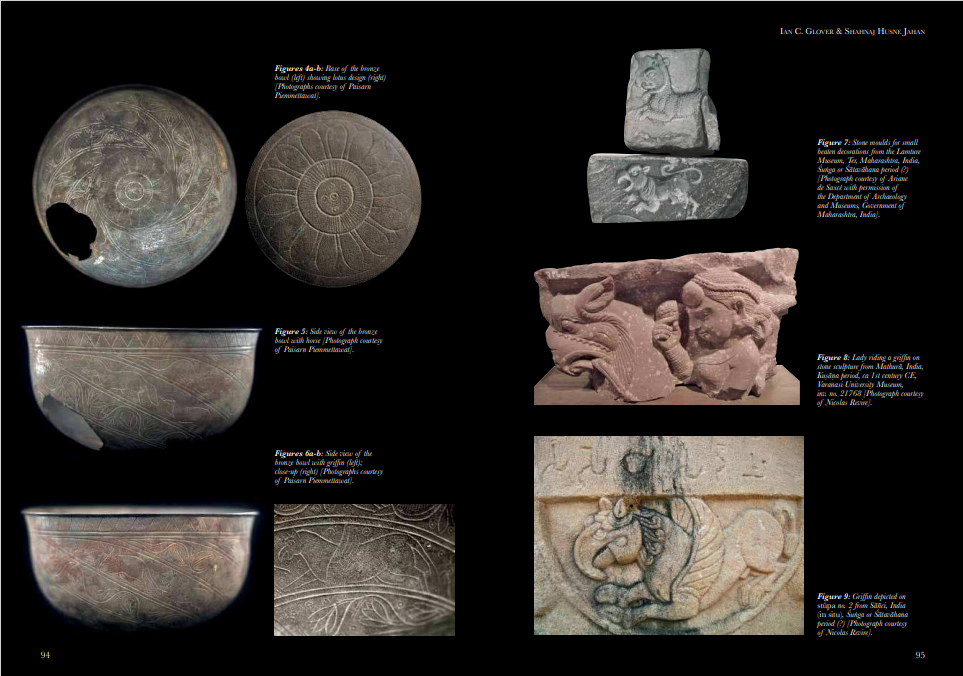|
|
|
|---|

| ชื่อผู้แต่ง | IAN C. GlOVER & SHAHNAj HuSNE jAHAN |
| วารสาร/นิตยสาร | - |
| เดือน | - |
| ปี | - |
| ปีที่ | - |
| ฉบับที่ | - |
| หน้าที่ | 91 - 97 |
| ภาษา | อังกฤษ |
| หัวเรื่อง | เขาสามแก้ว |
Towards the end of the second millennium BCE, bronze was introduced into Thailand and elsewhere in mainland Southeast Asia by various routes from China (Higham & Rachanie 2012: 145-146). In some areas, especially northern Vietnam, northeast Thailand and the areas east of the Chao Phraya valley, bronze largely replaced stone tools for everyday tasks, and for small ornaments. This regional “Bronze Age” lasted some ive hundred years and saw the widening of existing trade networks and the consolidation of settlements into mounded villages surrounded, especially in the Northeast, by moats and earthen banks.
From about 500 BCE, Southeast Asia entered into a major maritime exchange network that linked it with China, India and beyond to Persia and the Mediterranean world (Glover & Bellina 2011; Borell et al., this volume). This had profound cultural changes, involving the adoption of iron technology, irst into southern and coastal regions, seeing the introduction of a wide range of new prestige goods, such as glass and semi-precious stone beads, and most importantly, new concepts deriving from the religious and political cultures of India. Among the new products that appeared at three archaeological sites in Thailand, Ban Don Ta Phet, Khao Chamuk and Khao Sam Kaeo were some twelve high-tin bronze bowls with elaborate designs of people, animals in procession and building structures (Bennett & Glover 1992; Glover & Bennett 2012). Of these, one vessel stands out from the others on account of its more reined and naturalistic decoration and its early South Asian iconography and was certainly imported to Thailand at some time in antiquity as most probably were the other decorated vessels. The one we discuss and illustrate in this essay was said to have been found early in 2010 in the Tha Taphao river on the western edge of the archaeological site of Khao Sam Kaeo in Mueang district, Chumphon province, peninsular Thailand, an important archaeological site which has been surveyed, excavated and planned over a number of years by a French-Thai team led by Bérénice Bellina (2002; Bellina et al., this volume).
ภาชนะสำริด

Towards the end of the second millennium BCE, bronze was introduced into Thailand and elsewhere in mainland Southeast Asia by various routes from China (Higham & Rachanie 2012: 145-146). In some areas, especially northern Vietnam, northeast Thailand and the areas east of the Chao Phraya valley, bronze largely replaced stone tools for everyday tasks, and for small ornaments. This regional “Bronze Age” lasted some ive hundred years and saw the widening of existing trade networks and the consolidation of settlements into mounded villages surrounded, especially in the Northeast, by moats and earthen banks.
From about 500 BCE, Southeast Asia entered into a major maritime exchange network that linked it with China, India and beyond to Persia and the Mediterranean world (Glover & Bellina 2011; Borell et al., this volume). This had profound cultural changes, involving the adoption of iron technology, irst into southern and coastal regions, seeing the introduction of a wide range of new prestige goods, such as glass and semi-precious stone beads, and most importantly, new concepts deriving from the religious and political cultures of India. Among the new products that appeared at three archaeological sites in Thailand, Ban Don Ta Phet, Khao Chamuk and Khao Sam Kaeo were some twelve high-tin bronze bowls with elaborate designs of people, animals in procession and building structures (Bennett & Glover 1992; Glover & Bennett 2012). Of these, one vessel stands out from the others on account of its more reined and naturalistic decoration and its early South Asian iconography and was certainly imported to Thailand at some time in antiquity as most probably were the other decorated vessels. The one we discuss and illustrate in this essay was said to have been found early in 2010 in the Tha Taphao river on the western edge of the archaeological site of Khao Sam Kaeo in Mueang district, Chumphon province, peninsular Thailand, an important archaeological site which has been surveyed, excavated and planned over a number of years by a French-Thai team led by Bérénice Bellina (2002; Bellina et al., this volume).
ภาชนะสำริด